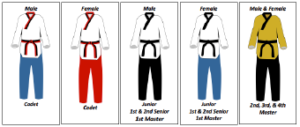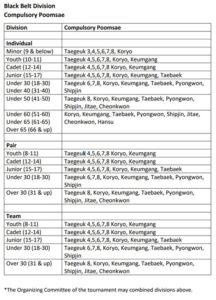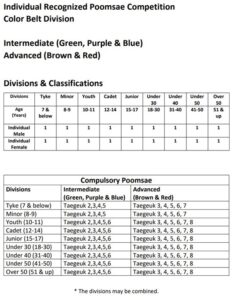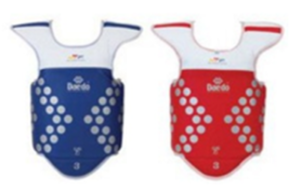REGISTRATION INFO, DEADLINES & FEES
All registration must be at www.autkdaz.com. 2025 AAU Taekwondo – Arizona State Championship – National Qualifier has a NO REFUNDS policy. All athletes and coaches must register and pay in full. If payment is not received by the deadline (February 16th, 2025), competitor(s) will be disqualified. All credentials must to pick-up on February 21st, 2025, from 5:30 PM to 8:30 PM at Hampton Inn Queen Creek. Registered coaches may pick up the credentials for their school athletes. WC competitors (min-cadet, cadet, junior, and senior) must present an ID to pick-up and weigh-in on February 21st, 2025.
TOURNAMENT
Referees: All referees must meet at Crismon High School, 21942 S Riggs Rd, Queen Creek AZ 85142, no later than 8:00 am the day of the tournament. All referees must officiate the full event for the honorarium. Please contact Master Chris Kim at email: hyunckim@gmail.com for details or to express your interest.
Event Credentials – All participants will receive an event credential when they arrive at the event check-in and weigh-ins on 02/21/2025 from 5:30 PM to 8:30 PM. All participants must provide a valid ID to pick up credential and to weigh-in. There will be no exception to this policy. Valid ID are the following: School ID, State Issued ID, Passport, or birth certificate. If the athlete is a minor and does not have a valid ID, then the parent/legal guardian must provide a copy of their birth certificate. The participant’s credentials are not valid for an adult, parent, or sibling of that participant. The event is a qualifier for the national championship – credential must be picked up with a valid ID for athletes or for the coaches.
Coach: To obtain a Coach Pass ($65), you must take the 2024-2025 AAU Coach online quiz.
then register online for the coaching credential at www.aautkdaz.com by February 16th, 2025.
Coach’s Dress code: Coach’s attire will be enforced at this tournament — NO EXCEPTIONS: Warm-up pants and official blue AAU shirt. Coach’s shirt can be purchased at the online at https://www.aamasupply.com
Spectators: All spectators (unless a designated VIP, Referee, or a Volunteer) must purchase an admission ticket and may not enter the arena floor at any time. Tickets will be available during the check-in on 02/21/2025 or 02/22/2025 at the door the day of the tournament.
IMPORTANT NOTE: The tournament director may modify some rules according to the local conditions. Director also reserves the right to combine or divide weight categories depending on the size of the group.
2025 AAU Taekwondo Arizona State Championship will apply the most current AAU Taekwondo Rule Handbook (updated 09/01/2024)
This event is Licensed by the Amateur Athletic Union of the US Inc
All participants must have a current AAU Membership. AAU membership may not be included as part of the entry fee to the event. AAU Youth Athlete membership must be obtained before the competition begins except where the event operator has a laptop available with an internet connection.
Be Prepared: Adult and non-athlete memberships are no longer instant and cannot be applied for at events. Please allow 10 days for membership to be processed.
Participants are encouraged to visit the AAU website www.aausports.org to obtain their membership.
Note: Any contacts listed within this flyer MUST have a current valid AAU Membership.
For more details about the competition information, please visit www.aautkdaz.com
Poomsae/Open Form/ Weapon:
A random draw will be completed prior to the start of competition to determine the order in which contestants will compete.
Competitors are required to perform only the Poomsae (forms) designated for their specific rank.
- Points shall be awarded on a scale of 7.0 to 10.0 in tenths of a point (0.1) increment, 7.0 being the lowest score awarded for a completed pattern. 8.0 shall be the score awarded by an Official for what that Official deems to be an average performance for that age and rank division in which the competitor competes.
- Forms/Patterns Can Not Be Altered or Modified. Do not add or leave out kicks or movements. Doing so can result in disqualification. No variation from the above list will be accepted.
- Merit will be awarded on the basis of beauty, grace, rhythm, focus, power, and technique.
- Traditional forms/patterns will be as bracketed competition – No Brazilian Repechage systemThe official Forms/Patterns accepted for competition shall be:
Rank ITF WT TSD/MDK Novice White, Yellow Orange
(6th Gup, 7th Gup, 8th Gup)
Chon-Ji Dan-Gun
Do-San
Pal Gwe 1–2 Taegeuk 1–2
Ki-Cho (KiBon) 1–3 Pyung-An/Pinan 1
Intermediate Green, Purple Blue
(3rd Gup, 4th Gup, 5th Gup)
Won-Hyo Yul Gok
Joong-Gun
Toi-Gye
Pal Gwe 3–6 Taegeuk 3–6
Ki-Cho (Ki Bon) 4-5 Pyung-An/Pinan 2–4
Advanced Red Brown
(1st Gup. 2nd Gup)
Hwa-Rang Choong-Moo
Pal Gwe 7–8 Taegeuk 7–8
Pyung-An/Pinan 5 Bassai (Dai & So)
1st Dan Kwang-Gae Po-Eun
Ge-Baek
Koryo Bassaai (Dai & So) Naihanchi Cho Dan
Jin Do
2nd Dan Eui-Am Choon-Jang
Ko-Dang
Juche
Keumgang NaiHanchi E Dan Naihanchi Sam Dan
Lo-Hai/Ro-Hai
3rd Dan Sam-Il Yoo-Sin
Choi-Yong
Taebaek Kong San Kun (Dai & So)
Sip Soo
4th Dan Yon-Gae Ul-Ji
Moon-Moo
Pyongwon Wang Shu 5th Dan So-San Se-Jong
Sip Jin Ji-On Sei Shan
6th Dan Tong-Il Jitae O Sip Sa Bo 7th Dan Chonkwon Hwa Sun 8th Dan Hansu 9th Dan Ilyeo In WTF or WT Traditional Forms, athletes perform WT forms (Taegeuk Forms for color belts and Koryo to Hansu for black belts) and are judged on aesthetic performance such as power, rhythm, speed, balance, and overall look of the form, not specifically on the specific technical skill. AAU officials are the judges for this event. They could be instructors from WT, ITF or TSD.
In Open Forms, WT, ITF & TSD forms competitors are allowed to perform in this event. Referees and judges judge based on the above criteria for the traditional (WT, ITF, TSD) forms.
World Class Poomsae Division:
Poomsae contestants may wear either the standard V-neck USA/WT uniform (as specified above) or WT-designated Y-neck competition poomsae uniforms appropriate to the contestant’s division.

Designated Poomsae will be selected from the Compulsory Poomsae listed below and will be published approximately 1 week from the start of the championship.


Rules: Scoring shall be made in accordance with the World Taekwondo Poomsae Competition Rules.
In Sports Poomsae, athletes are judged based on the rules and criteria set forth by World Taekwondo and have been adjusted by AAU Taekwondo. These criteria for judging include technical skills, such as using the correct execution, techniques, and movements. To keep it brief, forms are scored based on a specific criterion in two categories, Accuracy & Presentation. Poomsae referees and judges are trained and certified to judge the competition. This Sport Poomsae is an event by itself different from WT Traditional or Open forms event.
General Rules and Regulations for Olympic-Style Sparring
Protective Equipment
Mandatory Equipment for Non-PSS Matches. All competitors must wear:
- Olympic style chest protector.
- Headgear (the blue competitor must wear blue headgear and the red competitor must wear red headgear), exception, a white headgear will be allowed for the state/district qualifier; other than the headgear, no other item shall be worn on the head with the exception of religious headwear which shall be worn under the headgear and inside the uniform and shall not cause harm or obstruct the opposing competitor.
- Shin and instep protectors (white only and must be worn underneath the dobok).
- Forearm protectors (white only and must be worn underneath the dobok).
- Mouth-guard – May be any color except solid red. Athletes with dental braces must wear special mouth guards for braces that cover both upper and lower teeth.
- Males are required to wear groin protection (hard cup). Female groin protection
is optional. All groin protection must be worn inside the Dobok.
- Foot Gloves (in lieu of manufactured insteps) and Hand Gloves are optional for
colored belts and any divisions that are not using PSS, but if used must be white and
WT approved.
Mandatory Equipment When Using Electronic Protector and Scoring System (PSS).
- Both competitors shall wear the same size chest protector with the following
exception: When combining weight divisions resulting in extreme size differences in
the competitors, a competitor may be allowed to wear the PSS Electronic Protector
appropriate for their weight class, at the discretion of the Head Referee for the
event, however, they will be required to use the pressure settings of the division
they are moved into.
- Headgear – the blue competitor must wear blue headgear, and the red competitor must wear red headgear Other than the headgear, no other item shall be worn on the head with the
exception of religious headwear which shall be worn under the headgear
- Shin protectors (white only, no instep, and must be worn underneath the dobok)
- Forearm protectors (white only and must be worn underneath the dobok)
- WT approved white gloves
- Mouth guard – May be any color except solid red. Athletes with dental braces must wear special mouth guards for braces that cover both upper and lower teeth.
- Males are required to wear groin protection (hard cup). Female groin protection
is optional. All groin protection must be worn inside the dobok.
Equipment Color at Tournaments Other Than National Events
- At tournaments other than national events ONLY, the tournament director has
the option to waive the color requirement for the hand, foot, and headgear equipment.
2023 AAU Arizona State Champion (District Qualifier) will allow white headgear for both red and blue competitors. However, this rule only applies to this event only and that the gear color requirements will be strictly enforced at all national events.
Personal Requirements
Competitors shall keep their nails short and are forbidden to wear any metallic article that may injure or endanger an opponent. Hair shall be tucked inside the head gear.
- Metallic Articles. The phrase “metallic articles” includes all hard objects, which may
cause injury. It is not sufficient to cover a hard or metallic article such as a ring with tape or
other covering.
- Personal Hygiene. The personal hygiene of all competitors shall be of the highest standard. Any competitor wearing an excessively unkempt or dirty uniform will be required to change it immediately. If the competitor cannot or will not comply, the Referee shall declare the opponent the winner.
- Medical Tape. A maximum of three layers of tape are allowed except in the case of an
injury. For an injury, the minimum amount of tape that will protect the area should be
approved by the tournament medical team. Under no circumstances will a hard splint or
cast be allowed, no matter how small.
- The administration or use of any drugs (except antibiotics or other medically
prescribed therapeutics), alcohol, stimulants, or injections in any part of the body, either
before or during a match, to or by any competitor is absolutely prohibited. Any competitor
violating these rules will be disqualified.
- For all belt ranks 5 to 11 years of age (excluding the mini-cadet black belt
division age 10-11), “sport” eyeglasses will be allowed in Olympic Sparring competition.
Soft contacts are highly recommended. Regular eyeglasses are not allowed.
Compliance
- If a competitor, upon being called to the center of the ring to compete, is found in violation of Protective Equipment and Personal Requirements, that competitor will receive one minute to come into compliance. If within that one minute the competitor returns to the center ready to compete, he/she will receive a gam-jeom and the match will begin. If he/she does not return to the center ready to compete at the end of one minute an additional one-minute count down will begin. If that competitor returns to the center within the second one-minute period, then the competitor will receive a second gam-jeom and the match will begin. If the competitor does not return within the total two-minute grace period, that competitor may be disqualified.
Duration of Competition
| Age / Rank | Duration | Quantity | Rest |
| All Color Belts | 1 minute | 3 Rounds | 30 sec |
| Black Belts (5-9 & 10-11) | 1 minute | 3 Rounds | 30 sec |
| Black Belts (cadet / Executive 33+) | 90 seconds | 3 Rounds | 30 sec |
| Black Belts (Junior/and Senior) | 90 seconds | 3 Rounds | 30 sec |
Rest Time between Semi-Final and Final Match – Competitors shall be allowed at least two-minutes rest between semi-final and final matches.
Best of three (3) system – No golden round
Permitted techniques
- Fist technique: A straight punching technique using the knuckle part of a tightly clenched fist
- Foot technique: Delivering techniques using any part of the foot below the ankle.
Permitted areas
- Head Area (Foot techniques only permitted). The “head area” is all areas above the bottom of the headgear, including face, ears, top and back of head.
- Trunk. This area includes the entire trunk which is covered by the chest gear between the armpit and the pelvis. This includes the back, except for the spine. Attacks by fist and foot techniques are permitted.
If a legal implement hits a legal target area, but part of the striking implement also lands in an illegal area, it will be considered a legal strike.
Points (Valid Scores)
Points shall be awarded when permitted techniques are delivered accurately and powerfully to legal scoring areas of the body (The blue or red colored area of the body protector). Points shall be awarded when permitted foot techniques are delivered accurately to the head.
- Scoring Areas
- Body: The blue or red colored area of the trunk protector
- Head: The entire head above the bottom line of the head protector
Criteria for Valid Points
Points shall be awarded when permitted techniques are delivered accurately and powerfully to legal scoring areas of the body (The blue or red colored area of the body protector).
Points shall be awarded when permitted foot techniques are delivered accurately to the head.
- Points Awarded for Legal Attacks to Legal Scoring Areas:
|
Point |
| a valid turning kick to the head (continuous) | 5 Points |
| a valid turning kick to the trunk protector (continuous) | 4 Points |
| a valid kick to the head | 3 Points |
| a valid kick on the trunk protector | 2 Points |
| a valid punch on the trunk protector | 1 Point |
| Gam-jeom Penalty | 1 point |
| Point Gap (per round) | Gam-jeom (per round) |
| 12 | 5 |
If using PSS, determination of the validity of the technique, level of impact, and/or valid contact to the scoring area shall be made by the electronic scoring system. These PSS determinations shall not be subject to challenge from a coach.
- Match score shall be the sum of points for all rounds.
- Invalidation of Points. If a competitor records the point (s) while performing a prohibited act, the following actions will be taken.
- If the prohibited act was instrumental to the scoring of the point(s), the Referee shall declare the penalty for the prohibited act and invalidate the point(s)
- If the prohibited act was not instrumental to earning the points, the Referee may penalize the prohibited act, but not invalidate the point(s).
- When Using Electronic Protector and Scoring System (PSS) points scored on the mid-section of the trunk shall be recorded automatically by the transmitter in the electronic trunk protector. If Electronic Headgear is utilized, only points scored by the headgear shall be recorded automatically by the transmitter in the headgear.
 KPNP PSS System: All Black Belts Sparring Division will use the KPNP PSS System. Please, bring your own KPNP E-foot gear.
KPNP PSS System: All Black Belts Sparring Division will use the KPNP PSS System. Please, bring your own KPNP E-foot gear.
Prohibited Acts
The following shall be classified as prohibited acts, and gamjeom shall be declared.
- Crossing the boundary line with one foot touching the mat
- Avoiding or delaying the match
- Falling down
- Grabbing, holding or pushing the opponent
- Kicking below the waist
- Lifting the leg to block, and/or kicking the opponent’s leg to impede the opponent’s kicking attack, or lifting a leg and/or kicking in the air for more than 3 seconds to impede the opponent’s potential attacking movements, or a kick aimed below the waist
- Butting or attacking with the knee
- Hitting the opponent’s head with the hand
- Attacking and making contact to the opponent after Kal-yeo
- Attacking and making contact to a fallen opponent
- *Misconduct on the part of a competitor or a coach
*When a competitor or coach commits a second (2nd) excessive misconduct infraction, they will receive a yellow card and immediately be disqualified from that and any remaining competitions for that tournament
IVR (Instant Video Replay) and Appeals
Each coach shall have the following quantity of Challenge Cards for Appeals per match:
- Non-IVR matches: 2 cards
- IVR matches: 1 card
- Coach’s appeal is limited to only (1) action which has occurred within (5) seconds of the appeal. Once the coach raises the Challenge Card to request an appeal, it will be considered that the coach has used their allocated appeal, unless the Judge’s meeting satisfies the coach. If the coach’s appeal is successful and the contested request is corrected, the coach shall retain the appeal right for the match.
Coach may only appeal the following:
- Non-IVR matches
- Non-Head PSS / PSS: Attack to the head area for only their own contestant.
- Technical Point for either contestant.
- Wrong identification of fist attacking contestant by judges.
- Mechanical malfunction (1st round – center referee, 2nd & 3rd round – coach challenge card and gamjeom penalty will be given if no mechanical malfunction)
- Penalties by either contestant as follows:
- falling down
- crossing the boundary line
- attacking the opponent after kal-yeo
- attacking the fallen opponent.
- If the referee perceives a contestant to be staggering, bleeding or knocked down by a kick to the head, and so begins counting, but the attack was not scored by the head PSS, the referee may request IVR or judges review to make the decision for awarding or not awarding points after the count.
Protests
Filing a Protest. In case there is an objection to a decision; the appointed coach (and he/she alone) representing the athlete may file a written protest to the event head Referee or Tournament Director, along with a fee of $75 (cash only). The protest will be submitted on the official protest form. The appointed coach MUST inform the Referee or Team Leader of that match immediately that it is their intent to protest the match. The written protest itself must be filed within a reasonable period of time. However, if the protest involves in error in the management of that division, such as miscalculating the score or misidentifying an athlete, the correction must take place immediately.
Deliberation Process
After reviewing the protest application, the content of the protest must be arranged according to the criterion of “acceptable” or “unacceptable.” If necessary, the arbiter can hear opinions from the Referee, Judges, or Team Leader.
- If necessary, the arbiter can review the material evidence of the decisions, such as the written data (score sheets). Video WILL NOT be admitted as evidence to confirm or disconfirm the protest.
- Errors in determining the match results: Mistakes in calculating the match score or misidentifying a competitor shall result in the decision being reversed.
- Error in application of rules: When it is determined by the arbiter that the Referee made a clear error in applying the competition rules, the outcome of the error shall be corrected, and the Referee shall be disciplined and/or sanctioned.
- Errors in factual judgment: When the arbiter decides that there was clearly an error in judging the facts such as impact of striking, severity of action or conduct, intentionally, timing of an act in relation to a declaration or area, the decision shall not be changed and the official(s)s who have made the error shall be disciplined and or sanctioned.
- The decision of the arbiter will be final and there will be no means of further appeal.
Safety Rules Governing Olympic-Style Sparring for Youth Competitors
The following special section of the Competition Rules shall apply to all belt ranks 5 to 14
years of age and colored belts 15 to 17 years of age competing in the Olympic Style Division.
- General Rules. In the local/preliminary, District, Regional, and National level competition, the rules concerning a kick to the head area shall be as follows:
- The competitor is encouraged to kick to the head area; however, the kick must be light contact with absolute control, or the appropriate penalty shall be invoked.
- The competitor who executes a successful technique (light contact) will be awarded three or five points, whichever is applicable based on the type of kick.
- The competitor who executes a kick to the head or neck, which does not cause injury, but, in the judgment of the Referee, is deemed excessive, will receive a one-point penalty (gam-jeom).
- The competitor who executes a kick to the head or neck, which results in a minor injury, shall receive a one-point penalty. A minor injury is defined as an abrasion or bleeding caused by excessive contact. The Referee, with or without consultation with the tournament physician, shall determine if the abrasion or bleeding is a minor injury and if the attack is a non-excessive one.
- The competitor who executes a kick to the head or neck, which results in the inability of the opponent to continue, due to the injury, shall be disqualified. The Referee, with or without consultation with the tournament physician and or Team Leader, shall determine if the attack is excessive contact, and disqualification.
NOTE: Inability to continue because of fright, crying, or loss of will following a legal kick to the head does not constitute grounds for disqualification of the attacker.